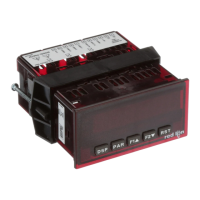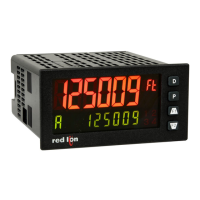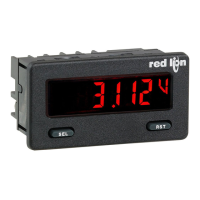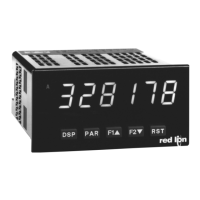PROGRAMMING MODULE #6 - PROGRAM ALARM/SETPOINT
If the alarm option is installed, this module is used to configure the operation
of the alarms to a variety of combinations. The programmable options are HI/LO
acting, auto/manual reset (latching), tracking, assignment to signal or totalizer,
display alarms, alarm values and hysteresis (deadband) values.
ALARM TRACKING
With alarm tracking, whenever alarm #2 is changed, alarm #1 will also change
so that the offset between alarm #2 and alarm #1 remains the same. This is useful
for hierarchical setpoints (pre-alarm and alarm) when one change applies to both
alarm values. When programming from the front panel, tracking only occurs
when PGM. DIS. is low (front panel lock-out mode, alarm #1 will not appear).
Tracking will always occur if alarm #2 is modified via serial communications
independent of PGM. DIS.
“trAc” < > “yES” or “NO”
DISPLAY ALARMS
If display alarms are desired, a message will flash on the display every 5-10
secs when an alarm activates. For alarm 1 the message will flash “AL1 on” and
alarm 2 will flash “AL2 on”, this warns an operator of an alarm condition. The
message will stop when the unit is no longer in an alarm condition.
“dISP” < > “yES” or “NO”
AUTO OR MANUAL RESET FOR ALARM #1
The reset action of alarm #1 may be programmed to reset automatically
(unlatched) or be programmed to require a manual reset (latched), through either
a remote input (E1-CON or optional E2-CON) or through the front panel.
Latched alarms are usually used when an operator is required to take some action
for the alarm condition.
“LAtC-1” < > “yES” or “NO”
ALARM #1 ASSIGNMENT TO INPUT SIGNAL OR TOTALIZER
Alarm #1 may be programmed to activate on either the input signal or the
totalizer value. If the totalizer option is not installed, this step defaults to the input.
“ASN-1” < > “INPUt” or “totAL”
PROGRAM VALUE FOR ALARM #1
The range of the alarm value is -99,999 to 999,999.
“AL-1” < > “-99999” to “999999”
PROGRAM HYSTERESIS VALUE FOR ALARM #1 (Cannot be
programmed if alarm latch is programmed)
The hysteresis (deadband) value for alarm #1 may be programmed from 1 to
99,999. The value is either added to or subtracted from the alarm value depending
on whether the alarm is high or low acting. (See “alarms” section for operation.)
“HyS-1” < > “1” to “999999”
ALARM #1 HIGH OR LOW ACTING
The action of alarm #1 may be programmed to activate either when the signal
goes above the alarm value (high acting) or goes below it (low acting).
“Act-1” < > “HI” or “LO”
AUTO OR MANUAL RESET FOR ALARM #2
The reset action of alarm #2 may be programmed to reset automatically
(unlatched) or be programmed to require a manual reset (latched), through either
a remote input (E1-CON or optional E2-CON) or through the front panel.
Latched alarms are usually used when an operator is required to take some action
for the alarm condition.
“LAtC-2” < > “yES” or “NO”
ALARM #2 ASSIGNMENT TO INPUT SIGNAL OR TOTALIZER
Alarm #2 may be programmed to activate on either the input signal or the
totalizer value. If the totalizer option is not installed, this step defaults to the input.
“ASN-2” < > “INPUt” or “totAL”
-15-
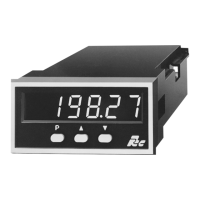
